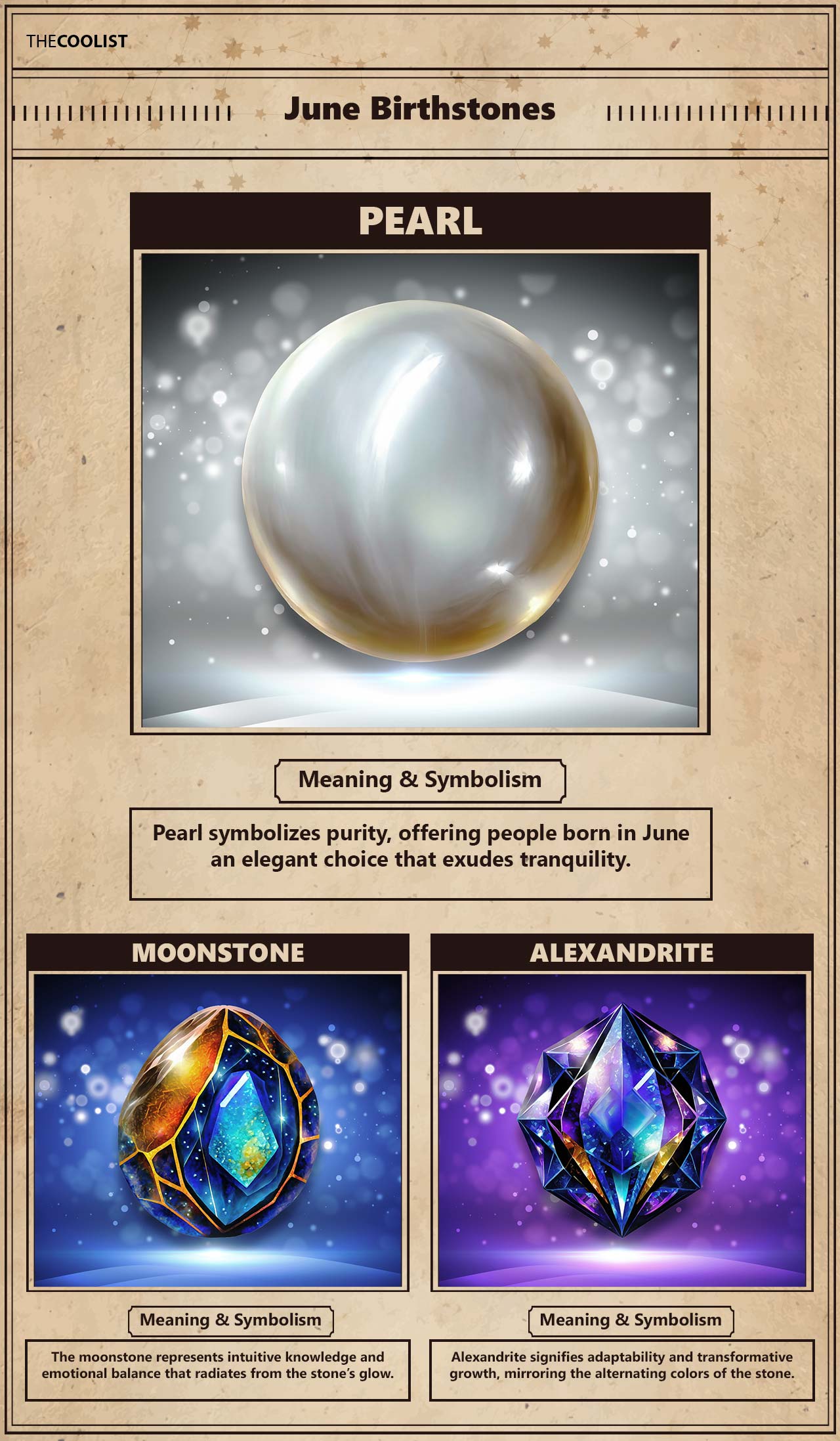The June birthstone choices are pearl, moonstone, and alexandrite, representing purity, intuition, and adaptability. Each June birthstone is renowned for its historical and metaphysical attributes corresponding to color patterns and gem formations. People born in June can wear pearls, moonstones, and alexandrite to reap the benefits of their stylish appearance and traits.

June pearls are renowned for their white and creamy iridescent color that embodies purity, innocence, and humility. Pearls are a popular gemstone in alleviating anxiety and instilling calmness in the wearer. Similarly, moonstones have been featured in jewelry for thousands of years. According to Hindi culture, moonstones are sacred birthstones that bring good fortune and blessings. Moonstones are characterized by their white, milky appearance with an adularescent sheen. The gemstone shimmers and glows like the moon when moonstones catch the light.
Meanwhile, June alexandrite gems are distinguishable by their color-changing properties. In daylight, the gemstone appears green, while under incandescent light, it shifts to reddish-purple. This unique property is known as the “alexandrite effect.” Alexandrite stones inspire duality and balance the mind and emotions, promoting emotional maturity.
The Jewelers of America, in their early 20th-century standardization and recent additions, embraced the three gems to reflect the diverse characteristics of people born in June.
Below, discover the meaning of each June birthstone and how using them can benefit your life.
What does the June birthstone mean?
Each June birthstone has a distinct meaning and symbolism corresponding to the pearl, moonstone, or alexandrite. Firstly, pearls symbolize purity and innocence. Their luminosity evokes the moon, which correlates to the divine feminine in astrology and other religions. Pearls have a solid connection to feminine energy, making them popular choices for women’s jewelry. Furthermore, pearls are symbols of new beginnings and fresh starts, inviting renewal and personal growth. Secondly, moonstones are linked to intuition, mystery, and femininity, enhancing a person’s intuition and emotional balance. Like the moon’s phases, moonstones are associated with new beginnings and inner growth. The lunar energy from the moon charges the moonstone June birthstone, making it incredibly potent in calming and tranquil energy.
Thirdly, alexandrite gemstones possess a unique color-changing property representing adaptability and change. Wearing the alexandrite June birthstone means you’re more open to the ebbs and flows of life as you find your feet on the path to new endeavors. Furthermore, alexandrite gemstones invite good fortune and personal growth. When wearing the alexandrite consistently, you’re more likely to feel an inner verve that draws positive people and choices into your life.
June’s birthstones offer a spectrum of energies ranging from the calming presence of pearls and the intuitive connection of moonstones to the joyful adaptability of alexandrite. Each stone symbolizes life facets that resonate with this summer month’s themes. These gems collectively represent the multifaceted nature of those born in June, providing a touchstone to their inherent qualities and aspirations.

What is the difference between modern and traditional June birthstones?
Modern and traditional June birthstones are distinguished in their variety and historical significance. Traditionally, pearls have been the quintessential June birthstones, prized for their classic white luster and long-standing history. While historical pearls were typically white, pearls come in various colors, including shades of pink, blue, and grey. However, alternatives such as cat’s eye, turquoise, and agate were once recognized for June. For example, a 19th-century poem assigns a birthstone for each month, and agate aligns with June. Variations of the poem exist that rewrite June’s verse and substitute pearl instead of agate.
In contemporary times, moonstone and alexandrite have been added as modern birthstones for June. These gemstones are available in diverse shapes and are celebrated for their unique visual properties, aligning with the varied personalities of June-born individuals.
What are the alternate birthstones for June?
June boasts three alternate birthstones: alexandrite, moonstone, and emerald. Alexandrite leads as a modern addition to the June birthstone list that encapsulates the essence of joy and adaptability, mirroring the dynamic nature of those born in this month. Following alexandrite is the moonstone, revered in Tibetan culture for its serene luminescence and the soft glow that seems to emanate from within. It is a stone of calm, intuition, and emotional clarity, aligning with the gentle progression from spring to summer.
Emerald is the guardian angel stone for June and radiates with its lush green hues, a symbol of growth. The emerald was esteemed as a traditional June birthstone for its vibrant greenery, echoing the month’s rejuvenating qualities. Together, these three stones offer a range of options that reflect the complex identities of people born in June.
Is there a June zodiac birthstone?
Yes, there are two June zodiac birthstones: pearl for Gemini and ruby for Cancer. Each June birthstone correlates to a specific energetic note that either Cancerians or Geminis exhibit. For example, the birthstone for Gemini is pearl, a gemstone that helps soothe and reduce negative energies. Geminis are adaptable yet complex individuals, so the pearl will resonate with them to enhance emotional balance.
Meanwhile, the birthstone most applicable to Cancers is rubies. Rubies are precious gemstones known for their deep red color, symbolizing love, passion, and vitality. Cancers are emotionally complex because the Moon, the planet of emotions and intuition, rules them. Therefore, rubies enhance Cancer’s lunar qualities, helping them channel conflicting emotions into compassion and love.
What color is June’s birthstone?
Each June birthstone has an iridescent sheen with varying colors depending on the stone and its formation. The traditional 1912 choice for June is the white or cream-colored pearl. However, pearls come in various shades, including pink, blue, grey, and black, depending on the type of pearl and its origin.
The modern additions to the June birthstone include Moonstone and alexandrite. Moonstones are characterized by their milky white coloring with shades of grey, peach, or rainbow hues. This creates a play of light on the surface, a prominent feature of moonstones. Meanwhile, alexandrites are known for their unique color-changing properties. In daylight, alexandrite appears green and shifts to reddish-purple in iridescent light.
What is the June birthstone crystal shape?
The following formations describe each June birthstone crystal shape and structure.
- Button: Button pearls are somewhat flat on one side and rounded on the other, resembling a button. They are commonly used in pearl earrings and are suitable for pieces where a slightly flatter pearl is desired for a sleek profile.
- Baroque: Baroque pearls are irregularly shaped, non-spherical pearls that can have unique and exciting forms. The term can also apply to other gemstones, including moonstones and alexandrites, that are polished but retain an organic, asymmetrical shape.
- Cabochon: A cabochon cut is characterized by a gemstone shaped and polished into a smooth, rounded top with a flat or slightly domed bottom without facets. It is a popular cut for moonstones to enhance their luster and alexandrites to emphasize their color change.
- Rough cut: Rough cut generally refers to gemstones, such as alexandrite and moonstones, that have been shaped and polished but retain a more natural, unrefined appearance. This type of cut is less about precision and more about highlighting the stone’s natural beauty.
Pearls, moonstones, and alexandrite arise from distinct formations. Pearls form within mollusks, layering nacre around an irritant, resulting in their characteristic luster. Colors range from white to deep hues, reflecting subtle iridescence. Moonstones, part of the feldspar group, develop in igneous and metamorphic rocks, displaying adularescence due to their layered structure. They possess a monoclinic crystal system, contributing to their asymmetrical forms and the iconic blue sheen on a translucent base.
Conversely, alexandrite, a rare chrysoberyl, exhibits a color shift from green to red, depending on the light, due to its orthorhombic structure and chromium traces. Alexandrite is prized for its distinct color change and rarity, especially in larger sizes and facets to accentuate its dichroic nature.
What’s the history of the June birthstone?
Each June birthstone carries a collective cultural weight, each with an ancient lineage that enriches its contemporary allure. The primary example of June’s birthstone lineup is pearls, one of the world’s most ancient adornments. They are treasured for their lustrous splendor, historically seen as celestial gifts and emblems of affluence. The pearl’s luminescent sheen has likened it to the moon, fostering its image as a symbol of purity and virtue, now integral to nuptial ceremonies and significant rites of passage. For example, a Hindu custom during the 20th century called for an undrilled pearl to be presented and a hole drilled on the wedding day.
The second June birthstone option of moonstones has an ethereal allure that boasts a storied past. For example, Symbols of Magic: Amulets and Talismans by Clifford Lindsey Alderman describes them as being venerated as divine relics within Hindu mythology, attributed to the lunar deity, Chandra. Their name, reflective of their bond with the moon, speaks to their essence of femininity and the cyclical nature of life, embracing intuition and fresh starts.
Alexandrite, the newcomer to June’s birthstone trove, emerged from Russia’s Ural Mountains in the 19th century, earning its name from Tsar Alexander II. It has a unique chameleon-like quality, causing it to shift from green to reddish-purple. The changing colors are a metaphor for adaptability and fortuity, capturing the dynamic spirit of change.
Where is the June birthstone found?
June birthstones are found throughout Asia, Africa, Australia, and Europe, depending on the specific stone. Natural pearls are obtained from both saltwater and freshwater environments spanning the globe. The Persian Gulf is a historic source of some of the world’s finest natural pearls. Other saltwater pearl sources include Australia, Indonesia, the Philippines, and the Red Sea coasts.
Moonstones are primarily mined in countries like India, Sri Lanka, Myanmar, Madagascar, and the United States. For example, India is famous for producing high-quality moonstones with the highly sought-after adularescent sheen. Comparatively, the most famous source of alexandrite is found in the Ural Mountains of Russia, where this gemstone was originally discovered. Russian alexandrite is highly valued for its exceptional color-changing properties, making the mining source a valuable commodity.
Is June’s birthstone rare?
Yes, June’s alexandrite birthstone is rare, while moonstones and pearls remain more readily available. Moonstones are ordinary stones, and their value is contingent on their adularescent sheen. High-quality moonstones with a vivid and distinct sheen are rarer and more valuable. Comparatively, natural pearls, particularly large, round, and high-quality ones, are exceedingly rare. Most pearls today are cultured and intentionally produced by inserting irritants into mollusks in controlled environments. While cultured pearls are more readily available, natural pearls are considered highly rare and valuable.
Meanwhile, alexandrite is among the world’s rarest and most valuable birthstones. Its rarity is primarily due to its scarcity and the geological conditions necessary to form the stone. The rarity of alexandrite is further emphasized by its unique color-changing properties, which collectors and connoisseurs highly sought after. Fine-quality alexandrite with a dramatic and well-defined color change is exceptionally rare.
June birthstone chart
Below is a chart detailing the core aspects of June birthstones.
| June birthstones | |
| Modern | Pearl, moonstone, and alexandrite |
| Traditional | Cat’s eye, turquoise, and agate |
| Zodiac | Pearl (Gemini) and ruby (Cancer) |
| Meaning | Purity, intuition, and adaptability |
| Color | Iridescent |
| Historical significance | A symbol of status and nobility |
What are the June birthstone personality traits?
The following five personality traits align with the qualities of each birthstone for June.
- Resilience: June’s alexandrite birthstone exudes resilience, which helps you adapt to change and proliferate inner growth. People born in June align with alexandrite’s flexibility and feel at peace to go with the flow in different situations, similar to the stone’s ability to change colors.
- Sociability: The alexandrite birthstone enhances your social skills as you’re more likely to enjoy social company and interact with a wide circle of friends. This stone encourages adaptability and eases the transition through changes, aiding in personal growth.
- Tranquility: Moonstones and pearls possess qualities that center your heart chakra to diminish distractions and promote tranquility. The constant reminder of serenity gives rise to a more nurturing and open to receiving love and affection.
- Insightfulness: June moonstones and pearls exhibit strong insightfulness, promoting an ability to read others’ emotions. These stones awaken your heart chakra, thereby improving intuitive capacities.
- Empathy: Pearls evoke purity and compassion that move to open your crown chakra to allow divine feminine energy to channel through your body. People who align with the intrinsic qualities of pearls are more empathetic and aware of others’ emotions.
Are there benefits to wearing a June birthstone?
Yes, the benefits of wearing a June birthstone vary with the chosen stone but coincide to bring positivity. Pearls promote emotional balance, fostering inner harmony and reducing stress. Symbolizing purity and innocence, pearls are meaningful for significant events like weddings and baptisms. Their connection to feminine energy and lunar cycles aligns with people born in June.
Moonstones enhance intuition and emotional balance, facilitating inner healing. They channel the moon’s energy, boosting creativity and intuitive powers supporting the wearer’s creative and emotional faculties. The heightened intuition instills the forethought necessary to protect yourself from harm. The added protective qualities echo the sixth month on the calendar’s connection to its numerological symbol, the number six, representing support and protection.
Alexandrite is known for its color-changing properties and embodies transformation, aiding self-development and personal growth. It brings good luck and acts as a protective talisman against negative energies, making it a powerful ally in uncertain times. Each June birthstone carries its strengths, offering tailored benefits to its wearer.
Which June birthstone should you wear?
You should wear the June birthstone that aligns with your personal preferences or spiritual beliefs and resonates with pearl, moonstone, or alexandrite. Pearls have a moon-like luster that symbolizes purity, wisdom, and tranquility, offering protection and prosperity. They resonate with the Gemini zodiac sign, enhancing their appeal to those who seek a connection with lunar energy. The moonstone gem exudes an ethereal charm and is prized for enhancing intuition and emotional well-being, perfect for those seeking personal growth.
Alexandrite attracts wearers with its remarkable color-changing ability and is heralded for fostering intuition and creativity, as well as attracting luck and prosperity, appealing to the versatile nature of people born in June. When deciding on a June birthstone, consider the aesthetic and symbolic resonance and the attributes you wish to embody, whether through pearls, moonstones, or alexandrite.
| Further reading on birthstones | |||||||||||
| January | February | March | April | May | July | August | September | October | November | December | |

